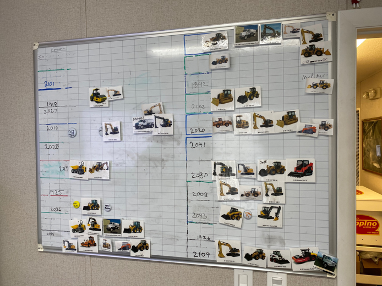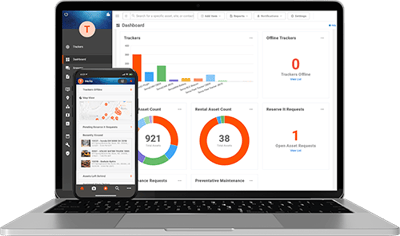
For contractors, it’s time to embrace modern construction technology to improve fleet management. Truthfully, it’s been time to do so. What on earth does that even mean?
Imagine having a complete understanding of your equipment fleet: where everything is, what’s in use, what’s available, what needs maintenance, and why; every excavator, generator, pump, truck, and everything in between. This would result in the difference between profit and loss, peace and stress.
This is not some unachievable dream; this is the reality delivered by construction data and a fully integrated platform to make sense of it for you. This combination provides the information contractors need to make decisions affecting their bottom line.
Real-time data in construction helps avoid spending excess time on the phone playing detective about your own equipment; it also limits time staring at the laptop, wondering what those spreadsheets of numbers actually mean. This is the power of big data in construction.
Integrated construction technologies can help predict the future availability of equipment by better understanding the present to permit better preparation for the future.
Telematics data, construction data, and GPS fleet analytics can be meaningful terms to you. They all deliver actionable information and can be used as tools in the same way as your equipment to help achieve goals and allow your business to grow.
Let’s get into the specifics of how meaningful and properly delivered construction data analytics can be crucial conduits that fuel the growth of your business.
How Fleet Management Was Before Big Data in Construction
 There has been a jump from physically written records into the digital age. However, many businesses still run a labor-intensive system that requires perfect record-keeping to manage their fleet effectively. Before getting into how construction data and analytics can simplify contractors’ work, take a look at the impractical, obsolete methods of fleet management to see if these ring familiar with your experience currently.
There has been a jump from physically written records into the digital age. However, many businesses still run a labor-intensive system that requires perfect record-keeping to manage their fleet effectively. Before getting into how construction data and analytics can simplify contractors’ work, take a look at the impractical, obsolete methods of fleet management to see if these ring familiar with your experience currently.
In the past, fleet management had a master ledger at the shop – white boards and pins on a map. Throughout the day they would be in constant contact with the field management team to review their notes, update any pertinent information about the equipment under their command, and hope there wasn’t something they forgot, weren’t told, or were wrong about. Precisely knowing where everything was sent, the maintenance it needs, was difficult if not impossible.
In recent decades, many contractors have gone digital, putting this ledger online to make it accessible to employees in different locations. Think Excel or Quickbooks: some type of program or platform makes access and input easier but does nothing to make managing your fleet any easier.
This was an improvement, but it’s still a system that requires seamless accounting of what went where, when, why, and for how long. In theory, it’s easy: superintendents and equipment managers keep track of equipment they handle on-site or at the yard, but real life and project demands make things more complicated than that.
Beyond the challenges of the system itself, it didn’t provide contractors with any useful information that would help them understand their business. They couldn’t learn about the profitability of a particular machine, the average time it took to complete a particular task, the utilization levels of their machines, and many other actionable pieces of information that could have guided their business decisions.
Why Do Contractors Need Construction Data and Analytics for Fleet Management?
Without useful information provided by GPS fleet analytics, contractors are (sometimes) aware of all the resources they have, but nothing beyond that. They know they have a particular machine (sometimes), but not its current condition, location, scheduled use, or past performance metrics.
In layman’s terms, operating a contracting business without construction data and analytics is comparable to an individual knowing they own a car, but not:
- If it runs
- Its mileage
- How much it costs to operate/maintain
- The last time they changed the oil
- If they lent it to anyone
- Who they lent it to
- Where that person parked it.
Knowing all that information about your car sounds useful, even crucial, doesn’t it?
The Challenges of Working Without Construction Data Analytics
Working without integrated construction data creates redundancies of efforts, lets important tasks get ignored, and fails to provide contractors with actionable data that charts a course for growth. It’s like trying to make choices with only half the information needed to do so.
Failing to utilize construction data analytics affects contractors in two significant ways.
- In terms of the bigger picture, it’s impossible to understand which decisions are working and which are holding the company back.
- In terms of day-to-day fleet management, it creates an impossibly complex task that can’t be accomplished.
Contractors Lacking Telematics Data Have Their Growth Capped
Contractors running their businesses without construction data informing their decisions eventually hit a growth ceiling. As a result, it becomes impossible to bid competitively, schedule accurately, or make the choices that lead to growth. No amount of technical expertise can make up for the failure to know machines’ levels of profitability and productivity.
Contractors bidding on jobs without accurate data informing their bid are relying on nothing more than intuition, memory, and hopes. They don’t really know how long it takes to complete a particular task, so they’re either overbidding to protect themselves against losses or underbidding to get the job and later realizing they underestimated what it would take to complete it.
In turn, this results in the inability to utilize the machines of their fleet effectively. Because it’s unclear whether or not a machine will be finished at job A in time to be transported to job B, it creates a situation where the contractor has two bad choices. They either unnecessarily rent a machine or run the risk of blowing the schedule by reaching an impasse where the equipment needed to continue working isn’t available.
Either outcome can potentially result in reduced profits, and even when it all goes well, it creates a tremendous amount of stress in the process. Spending every day on the phone with superintendents, asking how close the XYZ-machine is to finishing up so it can be taken to job B isn’t a productive use of time if it can be avoided.
Beyond the specific details, contractors lacking telematics data are perpetually spending time and money trying to solve the same problems over and over again. Even in the rare instances where a contractor has established an effective system to understand everything that proper data analytics could tell them, they’re still paying employees to do it.
Every contractor has heard and probably said, “work smart, not hard,” but many continue to manage their companies in contrast to this statement. There’s a misconception that every work-related action has to be an actual action, or it can’t be called work, but this attitude leads to lower levels of productivity.
The Absence of GPS Fleet Analytics Means Missing the Target
Redundancies are familiar to contractors. There are many calls, emails, texts, and meetings, all with the intention of solving problems, but they only waste time and give the sense that problems are being resolved.
As construction companies grow, the metrics of every variable increase except for one: the human ability to multitask. More workers, more job sites, more equipment, more maintenance, and more people frantically calling that they need a particular machine or the schedule will be blown.
Many contractors currently expect everyone to handle it and chalk up the losses incurred as “the cost of doing business.”
The troops on the ground do their best to keep track of everything, but then life and work happen. To paint a picture of what this looks like, imagine that at the same time:
- There’s a piece of equipment that’s not starting and needs to be repaired
- There’s a crew of laborers standing idle, waiting for instructions for what to do next
- There’s an engineer who just arrived with updated plans they need to discuss
- There’s an OSHA inspector poking around looking to speak with management
In the middle of all this, the superintendent gets a text from a nearby worksite saying, “Hey, we need an XYZ-machine to keep working, ours broke down; can we come grab yours?”
Quickly saying “SURE” is pretty much the only option for the superintendent at that moment. There’s just too much going on to justify stopping everything to follow the labor-intensive protocol required; one human can only handle so many things at once.
This creates a domino effect of added work as machines get misplaced, they fall into disrepair, jobs can’t continue as scheduled because the necessary equipment is absent or broken.
Now that we’ve covered what doesn’t work anymore, let’s look at how that can change.
What Are the Benefits of Data Analytics for Fleet Management and Integrated Construction Technologies For Contractors?
 It can seem at first glance that construction data and analytics are simply bells and whistles. In the past, perhaps that was true, but modern systems working across the full scope of construction businesses make a difference measurable in time and dollars. Here are the specific things that change as a result of good data and analytics systems.
It can seem at first glance that construction data and analytics are simply bells and whistles. In the past, perhaps that was true, but modern systems working across the full scope of construction businesses make a difference measurable in time and dollars. Here are the specific things that change as a result of good data and analytics systems.
Gain Operational Insights of Equipment
Telematics data makes locating and understanding any machine an instantaneous process. Hop on the phone, tablet, or laptop and go to the fleet catalog; there, it’s possible to see precisely where a particular machine is and its current status.
Precise geofences will send automated alerts to the main offices or fleet managers whenever machines leave the job site they are assigned to, reducing the chances of unapproved use and alerting of potential theft.
Beyond their physical location, telematics data provides operational insights into how machines are (or aren’t) being used. It becomes possible to know which engines are idling, what percentage of the workday a machine was in use and other actionable information.
This allows contractors to see the inefficiencies of their current operations and indicates how they can improve in the future. The results are reductions in wasted time and more efficient dispatching of their fleet in the future.
Detail Entire Fleet Condition
In addition to location, data makes it possible to see what condition a piece of equipment is in and keep valuable digital maintenance records. This can be as simple as checking when the last time it got routine maintenance, or as complex as reviewing its performance and maintenance history to determine the machine’s continued value to the business (or lack thereof).
The information can be used in a micro or macro perspective, either checking on a specific machine or looking at the fleet’s condition as a whole. Instead of sending repair workers to handle single fixes and then departing, get more out of their travel time by handling preventative maintenance needed on other equipment at the same site.
Accurate records also allow contractors to get the most value from their machines when it’s time to sell. Instead of trying to convince buyers of how well-kept a machine was, they can simply provide its maintenance history details. This prevents getting talked down on your sales price because of the inability to provide the proper paperwork.
From the perspective of mechanics and other repair workers, the visual interface makes for greater scheduling clarity. No longer are they giving rough estimates about how long something will take to repair because they’re uncertain about their workload; they’re able to see exactly what’s expected and in what order.
Expedite Repairs and Stop Losses
Conversely, the process of reporting breakdowns or the need for repairs is simplified for the operators using the machines. There are no longer miscommunications over who said what and when; it’s as simple as filing a report/request. All parties instantly have a clear record of all interactions and issues surrounding a machine with written or audio notes and photos. The simplicity of the request process itself encourages equipment operators to report problems with their machines.
Telematics data also makes it possible to trim unproductive assets from the fleet. As many contractors know from experience, certain machines always seem to cause a maintenance headache.
With accurate repair and maintenance records, it’s possible to quickly identify problematic equipment that’s constantly breaking down and not worth holding on to.
Calculate Equipment Ownership Costs
Accurate construction data also allows contractors to see the actual value of the equipment in their fleet. By understanding how often a machine is being utilized and what it costs to own and operate, they can accurately assess its value to the business as a whole.
Knowing the fuel consumption, routine maintenance, repair costs, ease of transportation, and other miscellaneous costs associated with each machine helps contractors see the bigger picture. Comprehensive telematics data prevents tunnel vision that only recognizes how useful a machine is for a particular task but not for the business overall. This perspective allows business owners to compare owning or renting specific types of equipment.
Should the nature of the jobs being taken on and those jobs’ accompanying needs for certain equipment change, that data will be consistently updating and easily digested to make the best economic decisions accordingly. It will always be clear when it makes sense to unload equipment from the fleet, move equipment to jobs, rent to save on transportation costs, or buy new equipment to save money in the long term by adding machines for clear operational needs.
This data can also inform the costs of taking on particular jobs more accurately during the bid phase by knowing the costs of the machinery that is required to complete such jobs based on past utilization.
Schedule More Precisely
With a communicative construction data platform, scheduling becomes notably easier. Instead of just sending equipment to job sites for eventual use, send it when it’s needed, and only for as long as it’s needed.
The overarching ability to plot the different equipment needed across the different stages of a job reduces the uncertainty of what’s available. Understanding what’s available or unavailable makes it possible to reserve required equipment rentals or plan equipment transfers between projects far ahead of time. Besides getting better rates than what last-minute rentals will charge, there’s tremendous peace of mind knowing you’ll get exactly the machine needed.
The benefits of scheduling control lead nicely into the last point, bidding.
Bid With Greater Confidence
Construction data and analytics make money for contractors.
The most challenging part of construction, whether it’s interstate infrastructure or specialty repairs, is managing the unknown variables. The work itself is usually straightforward for those that know their trade; it’s getting the equipment, the supplies, and the labor that make things difficult and unpredictable.
Utilization data from machine use on previous projects can help provide accurate estimates for how long a machine will be needed to perform a similar scope on a future project. When contractors can be more precise with their estimates, they can be more competitive at bid time.
Big data in construction can’t do anything about the weather, but it absolutely can mitigate other variables like maintenance, access, availability, and the cost of all of the above.
How Big Data and Integrated Tech Work Together to Help Contractors
Construction data analytics provide the greatest insights when they’re integrated with a larger system. All the features discussed in this article would be helpful on their own, but when they work in coordination with each other, contractors gain a true overview of their business.
This integration of various technologies combine to give a macro understanding of where money is being spent, where time is being wasted, and most importantly, where changes can be made to positive effect.
Regardless of how organized or dedicated a contractor is to running their business efficiently, it’s simply not possible for a human to know the physical location of hundreds of different machines simultaneously.
The proper construction data platform can do this, as well as indicate how often machines are used, the cost of running and maintaining them, the operators using them, and a wealth of other information that allows contractors to make the right choices for their business.
Some of these technologies, like GPS tracking, are not new. Because of that, some contractors might note that they have tried that, or even that they currently have that, but aren’t seeing any of the payoff; it’s understandable skepticism.
This is where construction technology has been What’s new about it is how it’s being successfully integrated with other technologies to produce a genuinely synergistic result.
Contact Tenna to see where integrated construction technology is going today, and how you can leverage your construction data and analytics to make a financial impact to your business.
About Russ Young
As Chief Business Development Officer for Tenna, Russ oversees the growth strategy for the organization by working with sales, partners and customers to ensure success. Russ brings two and a half decades of experience from Google, Amazon, Oracle and FMI in best practices for technology strategy, selection and adoption. He applies his knowledge from these organizations to build awareness and provide thought leadership to the construction industry. He emphasizes the importance of technology and picking the right tool for the job.
